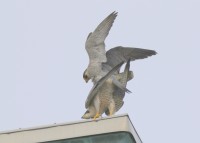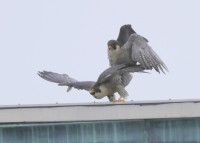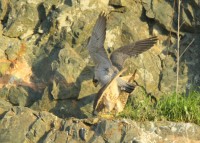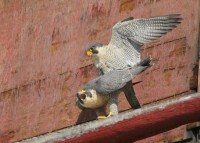Lawrence Peregrines: copulation
March 27, 2018 in lawrence peregrines, Near the Clock Tower, Peregrine Falcons Eastern Massachusetts, Peregrine Falcons Massachusetts
Made a pass by the Ayer Mill Clock Tower while heading to Industrial Way to observe the winter crow roost. Skies were overcast, winds were E at 7MPH, and temps in mid-forties. The male was in the nest box and then hopped out onto the wooden perch pole. The female arrived and landed on the SW corner of the New Balance building at 200 Merrimack Street. She cleaned her bill and then made a few soft calls to the nearby male. He swooped off of the perch pole and landed atop the female with talons carefully tucked in.
During copulation the female is pitched forward,making an angle of about 45 degrees with respect to the perch The copulation wail is given throughout. As the male mounts,the female spreads her wings out at the elbow about one-fourth open. The tail, up and to the side, may be partly spread.
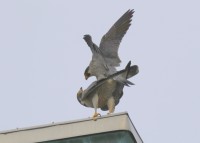 The male flaps his wings throughout copulation, maintaining an upright posture with the neck extended and bent in a curve. Usually the male gives one or two bursts of the Chitter vocalization just before,during,and/or just after mounting and then Eechips sporadically. Some individuals give bursts of Chitter throughout.
The male flaps his wings throughout copulation, maintaining an upright posture with the neck extended and bent in a curve. Usually the male gives one or two bursts of the Chitter vocalization just before,during,and/or just after mounting and then Eechips sporadically. Some individuals give bursts of Chitter throughout.
Toward the end of copulation the male stops his tail movements pressing his cloaca against the female’s. Rapid wing-beats accompany this tail-press. The female may spread her tail partly at this time,and the male departs with a Hitched-Wing Display directly afterwards.
Literature Cited:
Cade, T. J., J. H. Enderson and J. Linthicum. 1996a. Guide to Management of Peregrine Falcons at the eyrie. Boise, ID: The Peregrine Fund, Inc. (Excerpt: Linthicum, Janet. Observing Breeding Behavior)
Wrege, P. H. and T. J. Cade. 1977. Courtship behavior of large falcons in captivity. Raptor Res. no. 11:1-46.
